Breast milk is a perfect mix of everything that the baby needs to survive and develop. And it’s every mom’s wish that her infant will have enough of it for the first few months months. If your lactation expert confirms your fear of not producing enough breast milk, he/she is likely to recommend using a breast pump to improve your milk supply, before switching to baby formula.
The reason for this is centered in the law of supply and demand: pumping and emptying your breasts regularly triggers your milk-making glands to produce more milk. On the other hand, supplementing breast milk with formula leads to even lower breast milk production since the demand is low.
Using a breast pump may help you to deal with low milk supply, or remain good supply when you’re away from your baby and can’t nurse.

Here are my thoughts on 3 pumps often recommended to new moms with low milk supply. Here you’ll also find some useful tips that you should know, when a doctor or lactation expert advises you to get a breast pump to increase the amount of milk you’re producing.
This article is not a substitute for medical advice. It may contain affiliate links.
3 Best Breast Pumps Recommended For Low Milk Supply In 2022
There’s nothing like the ideal breast pump that would fit all moms. But it’s important to choose a proper pump that will suit your breasts, without causing soreness!
It should be easy to use and adjust. When you’re dealing with low milk supply the last thing that you need is a frustration and being confused because of a gadget that is complicated to use.
1. Spectra S1 Plus
Our verdict: Medium-price option with sufficient strength and tons of adjustments
If you don’t want to spend $1000+ on a hospital-grade pump, but need a strong breast pump for low milk supply, then the highly-recommendable model will be Spectra S1 Plus. This is a hospital-strength electric pump that packs a good punch in terms of suction while being hundreds of dollars cheaper than standard hospital-grade pumps.
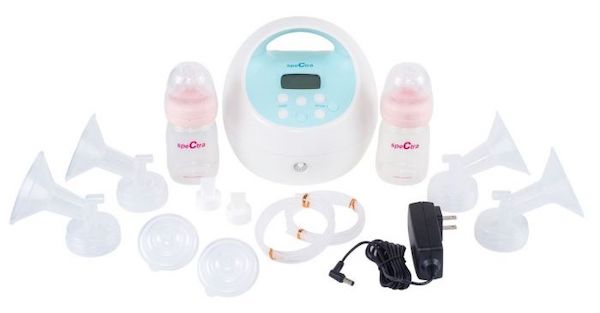
Spectra S1 Plus offers a maximum suction strength of 270mmHg adjustable in +/- 15 intervals. This is as powerful as most typical hospital-grade pumps get. In addition to its strength, this electric double pump has fully adjustable cycles. Once you get a good hang of these two settings, you’ll be able to narrow down to the perfect combination that allows you to pump more milk in less time, and with minimal discomfort.
Spectra S1 Plus starts in massage phase, which is meant to mimic your baby’s initial quick and shallow patterns that trigger let-down reflex. After let-down, it enters the expression mode, which again simulates the deep and slower suckling pattern that the baby switches to after the breast releases milk. A key selling aspect here is the ability to switch between these 2 phases at the touch of a button. Not many electric pumps allow this, despite being critical for moms who struggle to achieve a let-down. So this is a huge advantage of Spectra pump.
For moms who often spend several hours away from the baby, Spectra S1 Plus offers an amazing level of portability. First of all, this pump is super lightweight at 3 lbs. Secondly, it has a built-in rechargeable battery that lasts at least 3 hours of pumping with a single charge, which takes 4 hours. The freedom to use it while charging is priceless too. Lastly, this is among the quietest electric pumps out there.
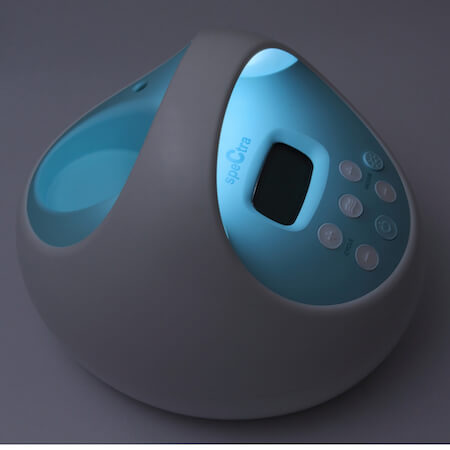
Other features that qualify Spectra S1 Plus as one of the best electric double breast pumps for low milk production include its closed system, which prevents mold growth in the tubes and contamination, BPA-free pumping parts, and a 2-level night light.
What to keep in mind
Spectra includes 2 sets of flanges in 2 sizes: 24mm and 28mm. They also offer breast shields in 20mm and 32mm sizes, but these are sold separately.
Secondly, its flanges are designed for wide neck bottles, but you can purchase an adapter for use with narrow neck bottles too.
Why moms love it
|
2. Medela Symphony
Our verdict: High-end & best choice for establishing lactation and dealing with low supply
Medela Symphony is a hospital-grade breast pump. Most of the time, the term hospital-grade means that the pump can be shared among several users (although each mom needs her own pumping kit).
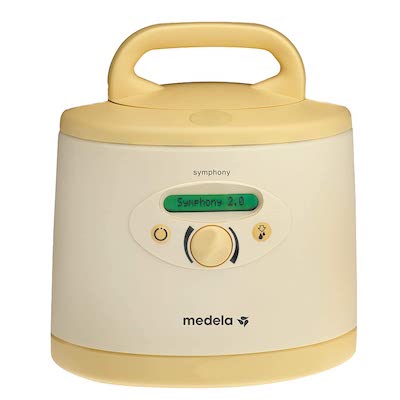
Perhaps the most significant attribute of Medela Symphony is that its overall design and technical features are based on clinical research. Importantly, this pump was designed to help moms who are struggling with low milk supply and those who have issues establishing and maintaining adequate milk production.
Medela Symphony has an adjustable suction strength of between 50 and 250 mmHg. The big knob on its face is what you use to play around with the vacuum strength to get to a comfortable level. This pump makes 40-120 cycles per minute. Unlike Spectra S1 Plus above, you can’t adjust the suction cycles of the Symphony. However, most moms report that the suction speed is one of this pump’s greatest strengths, and it’s less likely to cause sore nipples or lead to clogged milk ducts.
Like most electric breast pumps, Medela Symphony empties your breasts in 2 stages: stimulation and expression. After a successful latch, Symphony will switch from stimulation to the expression phase automatically after 2 minutes, in contrast to Spectra S1 Plus, where you have to initiate the next stage manually. However, you can also jump to expression mode in case of quick let-down or switch back to stimulation phase whenever you need to.
Medela Symphony is best used from one location, for instance, at a designated pumping corner in your room. Owing to its bulky design and heft, this is not something that you’ll want to haul to your workplace each morning more so if you use public transport. However, should you ever want to travel with it, it has a very sturdy carry case.
Again, it’s noteworthy that this unit needs to stay plugged-in when it’s emptying your breasts.
It’s impossible to deny that Medela Symphony is expensive, compared to other low-end electric dual pumps. But if you can afford to purchase it or rent one from a hospital or pharmacy, this is one of the best and frequently recommended breast pumps for low milk supply.
What to keep in mind
This dual breast electric pump is bulky and heavy (7 lbs) to move around with, which might present a lot of challenges for moms who work away from home.
Also, it’s worth pointing out that Medela Symphony (motor) can be shared with other moms, so you can rent it from hospital without worrying about contamination risk, however, you will need your own Double Pumping Kit which is sold separately (it costs around $55 – you can get you pumping kit here).
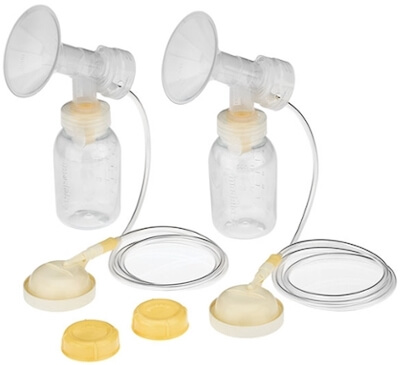
This kit contains 24 mm breast shields, and all necessary tubes, membranes, valves, caps and milk bottles. You can also get separately just the breast shields (for around $15) if the 24 mm size doesn’t fit you well. The choice is vast: 21 mm, 27 mm, 30 mm and 36 mm.
Why moms love it
|
Cheaper alternative to Medela Symphony
This is probably one of the most expensive pumps and usually moms rent it from hospital rather than buy it. However, if you need a pump for longer period, for example you plan on EPing, then renting may not be the best solution (financially).
There is however more affordable alternative to Medela Symphony which has similar strength, performance and quality, but costs a fraction of it: Medela Sonata. It offers hospital pump performance, but it’s much smaller and lighter, more portable and quiet!
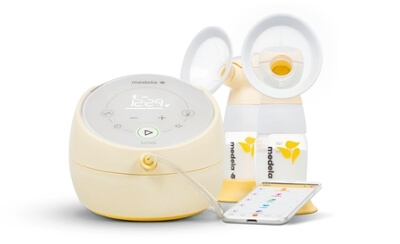
If you need hospital-strength breast pump, but can’t afford Medela Symphony and renting it seems not cost-effective at all, then Medela Sonata may be your best option.
3. Lansinoh Smartpump 2.0 Double Electric Breast Pump
Our verdict: Option for moms on tight budget
The last recommendation goes to all moms looking for the best affordable breast pump for low milk supply. This model is very similar to the breast pumps above operation-wise, but it’s a lot more pocket-friendly. It also has a few extras that tend to tickle most active moms’ fancy a lot. Let’s start with the basics.
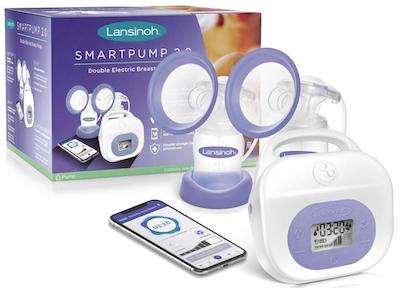
Lansinoh Smartpump is a dual breast pump, but it’s also usable as a single one if you want to nurse and pump concurrently. This pump has quite a good amount of suction. Although I can’t compare it to Medela and Spectra above, most moms report that their breasts feel empty after each pumping session with this model.
The package comes with everything that you need to start Pumping, including 2 pairs of flanges (25mm and 30.5mm), and storage bottles with lids.
For moms who are planning to return to work, Smartpump 2.0 ticks all the right boxes in terms of portability and convenient usage. To start with, this is among the most compact units by Lansinoh. It will comfortably fit in most work bags, but the best part is that it comes with a tote that fits all the pumping accessories for easy access. In addition, you can power this pump by plugging it or run it on batteries when there isn’t any outlet nearby.
Lansinoh Smartpump uses two-phase technology too. After setting it up, it will start in the let-down mode to initiate milk release. After 2 minutes, the motor will switch to expression automatically. A toggle on the control panel lets you switch between either of these 2 modes as your body dictates. After getting to the expression phase, this pump again allows you to choose between 3 pumping styles depending on which is closest to your baby’s feeding rhythm. It also has 8-level suction adjustments that allow you to tweak the expression phase as much as possible.
This pump has a large LCD screen that indicates battery level and how long you’ve pumping. Although you can control all aspects of this pump from its control panel, there’s an option to connect it to a mobile phone app via Bluetooth. From the app, you can keep a history of your breastfeeding and bottle feeding sessions plus diaper changes.
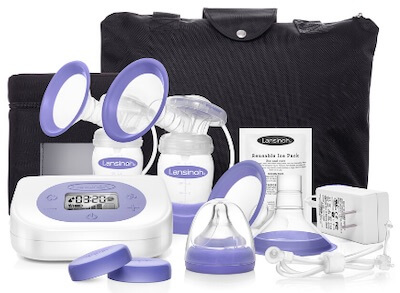
What to keep in mind
When not plugged in, Smartpump 2.0 uses 6 non-rechargeable batteries. Having an extra set of these batteries at the office or home will significantly reduce any inconveniences.
Why moms love it
|
What To Do If You Have Low Milk Supply
Consult your doctor and/or lactation expert first
There are a couple of things that you can do if you’re experiencing low milk supply. However, before self-diagnosing, it pays to consult your doctor or lactation expert first. At times, you may be mistaking your baby’s fussiness or multiple feeds for constant hunger.
If the baby isn’t getting enough milk, your doctor will do a few checks to determine whether you’re producing enough milk. He/she will also check if the baby is latching correctly and may recommend any necessary adjustments.
| PRO TIP: It’s always good to learn more about breast milk production to understand the reasons for low milk supply better! I recommend you two online classes by the Certified Lactation Expert: Master Your Milk Supply and Maximizing Your Pumping Output. You can find there tons of helpful information that will help you to understand your lactation better and work on increasing your supply. You can watch the lessons at your own pace whenever you want! |
Try to relax
Anxiety is the number one killer of successful breastfeeding. Anxiety affects milk production by increasing the levels of cortisol (the stress hormone). This hormone inhibits the performance of oxytocin, which is responsible for milk let-down.
Doing yoga is an excellent way of relaxing when breastfeeding. Another technique is to take a deep breath, hold it for a couple of seconds, and exhale slowly through the nose. Importantly, remember that being a new mom is difficult for every woman. So, don’t shy off from asking for any help whenever you can use it.
Prolonged skin-to-skin-contact
You probably know that skin-to-skin contact immediately after birth is essential for the well-being of mom and the baby. But do you know that it also helps with breastfeeding?
Having prolonged skin to skin contact helps in releasing the hormones responsible for lowering stress level for both of you. This contact also develops the baby’s instincts and suckling reflexes that aid in making a deep and comfortable latch when feeding.
How To Increase Milk Supply With Breast Pump
All moms have different bodies, needs and lifestyles, that’s why it’s so important to take time to choose proper breast pump. Especially when it’s supposed to help you increase your milk production.
There are however some basic rules, often recommended by lactation consultants.
1. Starting with the right pump and pumping equipment
Whichever model you choose to go with, ensure that you get a pair of breast shields that fits well. A model with customizable suction strength and speed is crucial too. These two factors help a lot in preventing pain, which is, actually, the number one reason why most moms aren’t successful with breast pumping.
BTW, remember about checking the pump condition regularly, to avoid any milk leaks and potential contamination. Read the manual and learn how to clean the whole equipment properly, replace parts when needed.
2. Increasing pumping sessions
During the lactation period, your body is wired to keep the breasts full in readiness for the next breastfeeding session. So, once you empty the breasts, your milk ducts start making a fresh supply almost instantly. This is a sort of supply and demand scenario where the body increases milk production to meet the demand.
If you are a working-from-home mom, you can increase breast milk supply by adding an extra pumping session or two to your baby’s feeding pattern. For instance, if she feeds 6 times a day, add one or two pumping sessions in between. These additional sessions may make it look like you’re ever pumping, but it’s a sure way of tricking your body that the baby needs more milk.
Importantly, remember to have these extra pumping sessions around the same time to enable your body to adjust and establish a routine.
Moreover, if you’re not pumping exclusively, but only wants to remain your supply while being away from the baby – try to pump at the same time as you usually nurse.

3. Cluster pumping & power pumping
These are the two techniques sometimes recommended for improving new mom milk supply.
Cluster pumping involves pumping more often, only that this is done in short clusters. Cluster pumping refers to pumping for 5-15 minutes, taking a 5-10-minute break, pumping again, followed by another break, and so on throughout one or several hour.
Power pumping is quite similar: first you pump your breasts as usual, then take a break for 10 minutes, then again pump for 10 minutes, and continuing this on-off cycle for 60 minutes. Lactation expert may recommend you to do it once a day for couple of days in a row.
Cluster and power pumping techniques are done to mimic the baby’s bunch feeds during a growth spurt. These intense periods of growth require a lot of energy, so the baby wants to feed regularly. The body responds to this increased demand by producing more milk.
In the same way, ‘imitating’ your baby’s bunch feeds by having several series of power pumping tricks the body into increasing the rate of milk production.
4. Using double breast pump
Have you ever wondered why the opposite breast leaks when breastfeeding? Well, one theory links this to the baby’s increased close contact with the mom. This theory suggests that pumping both breasts at once doubles the contact, thereby leading to increased stimulation. Notably, most studies have shown that double pumping often results in a slightly higher milk production than when pumping one breast at a time.
-
Collect milk from other breast while nursing
Using breast milk collector is a great way to collect a few extra ounces of milk from the opposite breast when the baby is breastfeeding. BTW, if you’re nursing and pumping, make sure that the baby feeds from both breasts, to keep the milk supply on the right level in both breasts.
5. Pumping after nursing
Pumping immediately after breastfeeding is yet another natural way of boosting milk supply. If your baby tends to favor one breast when breastfeeding, you’ll realize that that breast tends to produce more milk than the other.
Pumping both breasts after nursing helps the least favored side to keep up. But the best part is that it stimulates the body to continue making and producing more milk for longer, even after the baby has had enough. You may not get a lot of milk at first, but your body is getting the signals, and milk production will increase gradually.
6. Expressing milk in the morning
Moms often have higher volume of milk in the morning. This is because the supply of breast milk is largely regulated by hormones, as well as your circadian rhythm. Take advantage of this and try pumping in the morning, either before your little one wakes up or, as I mentioned above, shortly after nursing.
7. Healthy diet
It’s crucial to maintain proper diet, consume enough calories and stay hydrated! Whether you’re expressing milk with a pump or simply breastfeeding, remember to add some extra calories your diet! Choose proper type of calories, to provide your body (and your milk) with essential nutrients and minerals.
I found on many websites recommendations about lactation cookies and herbal supplements. Be careful! Studies on those things found inconsistent data – doctors are not sure whether or not supplements and herbs actually help with milk supply!
| As I mention in the next paragraph, some herbs may even cause problems with lactation. You should not try supplementation while breastfeeding without consulting with your doctor! |
8. Take online classes with Certified Lactation Expert
Learn more about breast milk supply and how to increase it in an online course created by Certified Lactation Expert. You can watch the lessons whenever you want, you don’t even have to get out of your PJs! I recommend you these classes about increasing milk supply by Milkology.
9. Stop comparing yourself with other moms
All women have different bodies. Even if two women have the same size breasts, their milk storage cells may differ. Some will be expressing milk faster, some will need more time to express certain amount of milk. Moreover, if you’re pumping occasionally, as opposed to exclusively, it may be a bit more difficult to express larger volume of milk and it may take longer.
If you’re worried about your milk supply or you’re not sure if you get enough milk with your pump, you should rather seek for a medical advice than compare with other moms.
Moreover, keep in mind that if your doctor confirms that your lactation and breastfeeding are well established, you won’t produce more milk than your baby actually needs. During that period, it may require multiple pumping sessions to express enough milk for one feeding, and even more to make a freezer stash.
Understanding Breast Milk Production & Supply
When the baby stimulates the nipple during feed time, a signal is sent from the nipples to the brain’s pituitary gland. Consequently, prolactin and oxytocin hormones are released into the blood.
Oxytocin is responsible for causing the alveoli (small sacs that produce and store milk) to contract and release the milk that is already stored in the breasts. This is called a let-down.
Prolactin hormone, on the other hand, stimulates the alveoli to start making more milk. The level of prolactin is notably lower during the first few minutes of feeding. However, 10-15 minutes after breastfeeding, the body increases the level of this hormone in the blood, consequently leading to increased milk production. The essence of this is to ensure that there is enough milk for the next feed.
Worth noting, milk production is based on supply and demand: the more the baby feeds, the more milk is produced. If the demand goes low, milk production is reduced too. That’s why it’s essential to pump regularly and effectively to maintain milk supply, if the baby isn’t emptying the breasts.
Why is my milk supply low?
Keep in mind that the reasons for low breast milk supply vary and to find proper strategy to deal with it, it’s crucial to consult with a certified advisor / doctor.
| The common reasons for low breast milk supply are:
|
How Much Milk Does The Baby Take During Each Feed?
The amount of milk that the baby takes varies depending on his/her age.
During weeks 2 and 3, the baby’s stomach can accommodate up to 5 ounces of milk per session and a total of up to 25 ounces per day. Daily milk intake will have increased up to 35 ounces by week 5.
From one month through 6 months, the baby’s growth rate will slow down a bit. Consequently, he/she will need almost the same amount of milk through this period. This is normal, it results from the fact that the milk changes in composition and calories and becomes more rich.
Since the demand is almost constant, milk supply is expected to be consistent too.
Baby Isn’t Getting Enough Milk – What To Look Out For
The fear of low milk supply is often accompanied by the thoughts of the baby not getting enough breast milk. As a general rule, if the baby is feeding 8-12 times every 24 hours, and he/she seems happy after each session, the chances are that they are getting enough. Gradual weight gain is another vital sign of a child who is feeding well.
On the other hand, here are some signs that show your baby might not be getting enough breast milk:
- Baby showing signs of low energy or excessive sleep
- Poor latch or painful latch
- Failure to regain birth weight within 10-14 days after birth
- Dark-colored urine and few soiled nappies
Generally speaking, if you’re worried that your baby isn’t taking enough milk or you’re concerned that your milk supply is low and/or don’t know if you should stimulate your lactation with breast pump, consult your doctor or lactation expert.
References:
https://www.healthline.com/health/parenting/how-to-increase-milk-supply-when-pumping
https://www.medela.com/breastfeeding/mums-journey/low-milk-supply
https://www.mayoclinic.org/healthy-lifestyle/infant-and-toddler-health/
Sources of pictures:
Pictures of Spectra S1 Plus belong to Spectra (source)
Pictures of Medela Symphony belong to Medela (source)
Pictures of Lansinoh Smartpump 2.0 Double Electric Breast Pump belong to Lansinoh (source)
The purpose of this article is informative. It’s not a substitute for medical consultation or medical care. Remember: safety first! Before you start breast pumping and/or have any doubts about your or your baby health condition, consult with a qualified lactation advisor and/or your GP!
| Your trust is really important to us: This article includes affiliate links to products that we think are useful for our readers. If you make a purchase through these links, we may earn a small commission at no extra cost to you. Your support helps us run this blog – thank you! |

